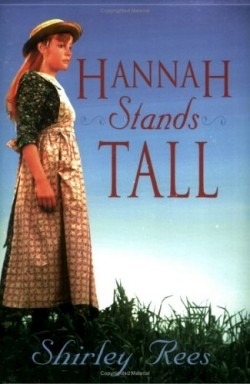Hannah Stands Tall
Hannah is fourteen years old in 1866, living in the Utah territory. The story begins shortly after her mother and sister have died of diphtheria, and Hannah has assumed the home duties and primary care of her four younger siblings. “Should have been a pleasant time, logs crackling, the mingled aroma of a wood fire and simmering chicken stew, but without Ma’s smiling face and cheerful voice, my heart was as gray as those clouds.” Her father carries on as usual, which causes Hannah to feel angry, because he does not appear to be grieving.
Hannah’s strength is constantly tested by the hardships of territorial living, which include Indian attacks, mountain lions, floods and droughts, a domineering aunt, and a deep fear of the water that had swept her best friend away to death. Even deeper is her fear that her silent father does not love her. Eventually, she understands her father’s stoic ways and “stands tall” as a strong young woman of the frontier.
The story paints a real picture of the simple pleasures and the backbreaking work of pioneer life: “I shuddered when I thought of what would follow-hours of carding, dyeing, spinning, weaving and knitting. And the soap! We’d soon be needing to make more soap from lard and cottonwood ashes.” Despite the fact that each short chapter presents and resolves a new crisis and there is some repetitious colloquialism—“how long you reckon” … “we’d be right happy” … “dang blast it”—the story moves along smoothly with plenty of excitement to keep a young reader’s attention.
The author is a native of Utah and has drawn Hannah’s story from her own family’s journals, which were written while they were settling Southern Utah. Rees is a retired elementary school teacher; she and her husband have six grown children. Young people aged ten to fifteen will enjoy this story of growing up in the early West because of the realistic word pictures Rees paints and the ever-constant action.
Reviewed by
Linda Cooley
Disclosure: This article is not an endorsement, but a review. The publisher of this book provided free copies of the book to have their book reviewed by a professional reviewer. No fee was paid by the publisher for this review. Foreword Reviews only recommends books that we love. Foreword Magazine, Inc. is disclosing this in accordance with the Federal Trade Commission’s 16 CFR, Part 255.

